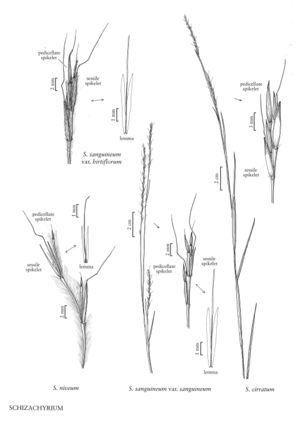Difference between revisions of "Schizachyrium niveum"
FNA>Volume Importer |
imported>Volume Importer |
||
| (4 intermediate revisions by 2 users not shown) | |||
| Line 4: | Line 4: | ||
|publications= | |publications= | ||
|common_names=Pinescrub bluestem | |common_names=Pinescrub bluestem | ||
| + | |special_status={{Treatment/ID/Special_status | ||
| + | |code=E | ||
| + | |label=Endemic | ||
| + | }} | ||
|basionyms= | |basionyms= | ||
|synonyms= | |synonyms= | ||
| Line 17: | Line 21: | ||
-->{{Treatment/Body | -->{{Treatment/Body | ||
|distribution=Fla. | |distribution=Fla. | ||
| − | |discussion=<p>Schizachyrium niveum is an endangered, rare species known only from central peninsular Florida, where it occurs in openings and sandhills of Ceratiola-pine-oak woodlands. It has been reported from south central Georgia, but Bruner (1987) found no evidence for the report. Of the two recent collections in Florida, he relocated one, in an area favored by real estate developers.</p> | + | |discussion=<p><i>Schizachyrium niveum</i> is an endangered, rare species known only from central peninsular Florida, where it occurs in openings and sandhills of <i>Ceratiola</i>-pine-oak woodlands. It has been reported from south central Georgia, but Bruner (1987) found no evidence for the report. Of the two recent collections in Florida, he relocated one, in an area favored by real estate developers.</p> |
|tables= | |tables= | ||
|references= | |references= | ||
| Line 26: | Line 30: | ||
-->{{#Taxon: | -->{{#Taxon: | ||
name=Schizachyrium niveum | name=Schizachyrium niveum | ||
| − | |||
|authority=(Swallen) Gould | |authority=(Swallen) Gould | ||
|rank=species | |rank=species | ||
| Line 34: | Line 37: | ||
|family=Poaceae | |family=Poaceae | ||
|illustrator=Linda A. Vorobik | |illustrator=Linda A. Vorobik | ||
| + | |illustration copyright=Utah State University | ||
|distribution=Fla. | |distribution=Fla. | ||
|reference=None | |reference=None | ||
|publication title= | |publication title= | ||
|publication year= | |publication year= | ||
| − | |special status= | + | |special status=Endemic |
| − | |source xml=https:// | + | |source xml=https://bitbucket.org/aafc-mbb/fna-data-curation/src/200273ad09963decb8fc72550212de541d86569d/coarse_grained_fna_xml/V25/V25_1619.xml |
|subfamily=Poaceae subfam. Panicoideae | |subfamily=Poaceae subfam. Panicoideae | ||
|tribe=Poaceae tribe Andropogoneae | |tribe=Poaceae tribe Andropogoneae | ||
Latest revision as of 17:57, 11 May 2021
Plants cespitose. Culms 49-90 cm, not rooting or branching at the lower nodes. Leaves usually completely glabrous; sheaths keeled; ligules 0.5-1 mm; blades 2.5-10 cm long, (1)2-4 mm wide, flat, without a longitudinal stripe of white, spongy tissue. Peduncles 2-4.6 cm; subtending leaf sheaths 2.5-4 cm long, 1.5-3.5 mm wide; rames 2.5-4.5 cm, somewhat open and usually partially exserted, varying from included to completely exserted; internodes 3-7 mm, straight, densely villous for their full length, hairs 0.5-2.5 mm, silvery-white. Sessile spikelets 5-6.5 mm; calluses with 0.5-1 mm hairs; lemmas slightly indurate at the base (unique among the species treated here in this respect), cleft for 3/4 - 7/8 of their length; awns 10.5-15 mm. Pedicels 5-6.5 mm long, 0.1-0.2 mm wide at the base, flaring beyond midlength to about 0.5 mm, densely villous. Pedicellate spikelets 0.5-2 mm, sterile, unawned or awned, awns 1-2 mm. 2n = 40.
Discussion
Schizachyrium niveum is an endangered, rare species known only from central peninsular Florida, where it occurs in openings and sandhills of Ceratiola-pine-oak woodlands. It has been reported from south central Georgia, but Bruner (1987) found no evidence for the report. Of the two recent collections in Florida, he relocated one, in an area favored by real estate developers.
Selected References
None.
